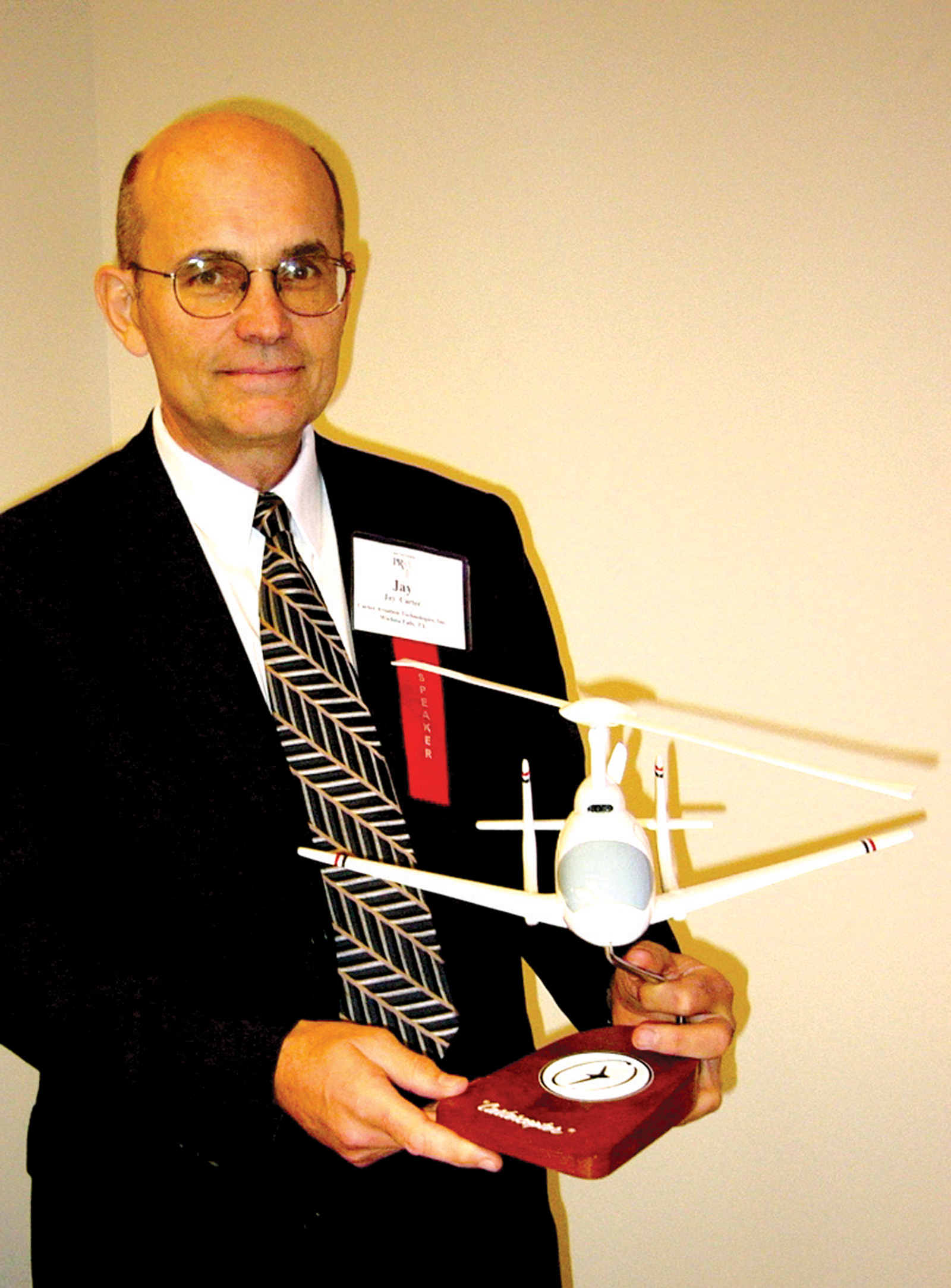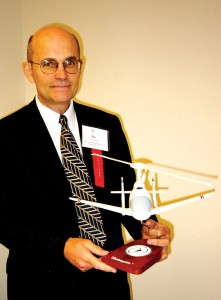By Jack Elliott
Jay Carter Jr. is a dreamer–and he ranks right up there with the best of them. His dream is to produce an aircraft that will fly people wherever they want to go without a pilot. It could take off right from your home.
Carter has been working on that dream for more than 10 years, and he’s made considerable progress. A prototype of his dream machine has flown for seven years.
Speaking at a meeting of the Public Relations Society of America’s annual New York MegaTech Day program at the New York Institute of Technology on September 29, Carter gave some graphic descriptions of how his revolutionary transportation system would work.
“Grandma and Grandpa could get in this aircraft on their driveway, push a button and fly to wherever they want to go,” he said. “The aircraft doesn’t need a pilot.”
It doesn’t need a runway either; it’s a vertical takeoff and landing machine. The CarterCopter, as it’s dubbed, would be guided by a global positioning system. It would be an extremely safe vehicle because GPS would also provide traffic separation.
“The military is operating unmanned aerial vehicles now, which talk to each other,” Carter pointed out. “When they get on a converging course, the communications systems automatically provide separation. The system might send one aircraft up and the other down.”
There’s plenty of skepticism among those who have heard about his dream of pilotless flight, but Carter discounts that.
“Remember when people wouldn’t ride in an elevator unless it had an operator?” he asks.
His vehicle is basically a gyroplane, a cross between an autogyro and a fixed wing aircraft. It has a rotor and a wing. The rotor is used for a jump takeoff, and the wing provides lift in high-speed cruise.
“You hold the brakes and the engine spins the rotor up until enough speed is achieved by the rotor to rise vertically about 50 feet,” he said. “At sea level, this can be achieved with the aircraft at full gross, which, for the five-place prototype, is 4,500 pounds. The engine is then disengaged from the rotor and power is applied to the prop, which provides forward speed. After it accelerates to 50 miles an hour, the wings begin to provide lift and the rotor blade will auto-rotate.”
Carter said the CarterCopter is a candidate for the “highway in the sky” program of personal aircraft currently under development by NASA, which could revolutionize personal travel. NASA believes, however, that the vertical takeoff and landing vehicles, such as the one Jay Carter is developing, are still 15 years in the future. Carter believes, however, that with proper funding his vehicle could be on the market in two to three years.
“It’s a safe machine,” says Carter. “If you run into weather it can land without power using autorotation of the rotor. It’s like pulling off at the side of the road in bad weather.”
The aircraft will use auto gas and you could set it down and drive into a gas station to fill up. The wings fold up so you could drive it down the road and you could achieve speeds of up to 60 miles an hour. The five-place prototype, which underwent a wide variety of flight tests for seven years, is powered by a modified Corvette engine of approximately 350 hp. The aircraft is constructed of composite material.
The roadable version now in the design stage would use the rudder pedals for steering and the throttle as an accelerator, thus simplifying both construction and operation. But there are still a number of design hurdles to overcome. Road vehicles require turn signals, brake lights, air bags, and under a reasonably new regulation, bumpers that will absorb a five-mile-per-hour impact. All of these requirements and more create design challenges. But solving such challenges is what Carter Aviation Technologies is all about.

Since the CarterCopter will use auto gas, you could set it down and drive into a gas station to fill up.
Carter has a number of versions of his aircraft on the drawing board, ranging from a two-place personal aircraft, which would be powered by a Rotax engine, to a military version that would carry up to 130 troops and armor. All of these models could achieve a speed of at least 230 miles an hour based on breakthrough technology developed by Carter Aviation Technologies.
One of the problems with rotorcraft is speed limitation. The problem is based on rotor speed. In a gyroplane, which has wings for lift and a propeller for thrust, rotor blade speed limits aircraft speed because it creates drag. Limiting rotor speed can reduce that drag, but it also reduces stability.
Carter has solved the problem. It’s highly technical, but basically what they’ve done is put weight in the rotor tips and created a stiff blade, both of which contribute to a slower rotor speed while maintaining stability. This is possible because the blades don’t have to provide lift once a high-speed cruise is achieved since the wings provide the lift. By slowing rotor speed, they also get rid of much of the noise created by the rotor blades.
The basic problem Carter solved involves the ratio between rotor speed and aircraft speed. When the rotor tip speed and the aircraft speed equal each other that is known as the MU-1 ratio. By slowing the rotor rpm down, the rotor drag is dramatically reduced, which improves efficiency and increases speed.
For years, industry research, including work by Carter, has attempted to break this barrier, but failed. On June 17, 2005, however, on a routine test flight of the CarterCopter prototype, pilot Larry Neal achieved this goal for the first time. Carter Aviation Technologies holds a patent on this development, along with 15 other patents on its futuristic technology.
The CarterCopter has made one public demonstration; that was at the Experimental Aircraft Association’s 2002 AirVenture in Oshkosh. There were many who didn’t think this aircraft could fly. Spectators at the demonstration were amazed by its performance, despite the fact that jump takeoffs and vertical landings, as well as other capabilities, weren’t demonstrated.
Carter decided, however, not to do any other public demonstrations. Part of his reason was that the aircraft was being used in tests being done under contract. In any case, the aircraft was damaged in an emergency landing in trees on June 17, on a separate flight from the one that achieved MU-l earlier on the same day, and suffered considerable damage.
It will not be rebuilt for flight, but may be reconstructed for a museum as the first aircraft of its type. The pilot walked away. A second prototype, a more advanced two-place version, is being built and is scheduled to fly next summer.
Among the selling points Carter offers for his personal aircraft is the fact that it will be very quiet and there will be very little vibration. The slow speed of the rotor and its rigid blade reduce rotor noise, and the 2000 rpm prop, which has a lower tip speed, is also very quiet. In addition, the craft will be very fuel efficient. The four- or five-place model gets 20 miles per gallon, using auto gas rather than avgas.
Carter said the cost of the aircraft will be about $15,000 for the two-place model and $20,000 for the four- or five -place model. He bases this on high volume production of 200,000 plus a year, which would bring the cost way down. He says all the avionics necessary could be built into something the size of a laptop computer and in volume production could cost as little as $1,000.
He’s working on a six-place model designed to have a coast-to-coast range. It would make the trip in eight hours, traveling more than 300 miles per hour. This model would have a small lavatory. He can foresee a 500-mile-per-hour jet version.
Carter doesn’t plan to manufacture the aircraft he’s designing.
“We’re engineers,” he said. “We develop the technology and the aircraft. We wouldn’t manufacture it but would license manufacturing rights to a company whose business it is to build things.”
What kind of company did he think would manufacture a CarterCopter-type craft?
“I think it will be an automobile manufacturer,” he said.
Carter Aviation Technologies, which was established in 1994 and is located in Wichita Falls, Texas, has completed contracts with NASA and with the Army. One was with NASA under a Small Business Technology Transfer award for Personal Air Vehicle Research, in partnership with the Georgia Institute of Technology in Atlanta, Ga. Carter also completed three research projects under contract with the Defense Advanced Research Projects Agency; one was on props, one on rotors, and one on landing gear for a six-place aircraft that could take a 24-feet-per-second drop.
Carter earned a pilot’s license when he was in college. He has logged 750 hours, but most of his flying was logged years ago. He holds a degree in mechanical engineering from Texas Tech; after graduation, he took courses in aeronautical engineering at both Texas Tech and the University of Texas at Arlington.
During his college days he built a gyroplane with encouragement from his father who was a pilot; they both flew it. His father, also a mechanical engineering graduate of Texas Tech, was a pioneer in the building of casings for rocket propellants. He built the casings for submarine missiles such as the Polaris and Minuteman.
Jay Carter Jr. has three children, two sons, Jay III and Matt, and a daughter, Megan, all of whom hold mechanical engineering degrees from Texas Tech. His daughter is studying law and plans to become a patent attorney.
The biggest challenge Carter faces at the moment is to raise enough money to continue research and to build more demonstrators. A lot depends on Carter’s ability to raise money. There is no doubt in his mind, however, that personal air transportation holds the key to transportation in the future.












